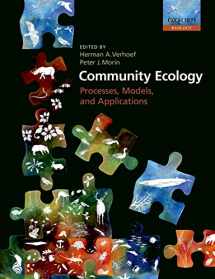
Community Ecology: Processes, Models, and Applications
ISBN-13:
9780199228973
ISBN-10:
0199228973
Edition:
1
Author:
Peter J. Morin, Herman A. Verhoef
Publication date:
2010
Publisher:
Oxford University Press
Format:
Hardcover
262 pages
FREE US shipping
Book details
ISBN-13:
9780199228973
ISBN-10:
0199228973
Edition:
1
Author:
Peter J. Morin, Herman A. Verhoef
Publication date:
2010
Publisher:
Oxford University Press
Format:
Hardcover
262 pages
Summary
Community Ecology: Processes, Models, and Applications (ISBN-13: 9780199228973 and ISBN-10: 0199228973), written by authors
Peter J. Morin, Herman A. Verhoef, was published by Oxford University Press in 2010.
With an overall rating of 4.5 stars, it's a notable title among other
books. You can easily purchase or rent Community Ecology: Processes, Models, and Applications (Hardcover) from BooksRun,
along with many other new and used
books
and textbooks.
And, if you're looking to sell your copy, our current buyback offer is $0.55.
Description
Community ecology is the study of the interactions between populations of co-existing species. Co-edited by two prominent community ecologists and featuring contributions from top researchers in the field, this book provides a survey of the state-of-the-art in both the theory and applications of the discipline. It pays special attention to topology, dynamics, and the importance of spatial and temporal scale while also looking at applications to emerging problems in human-dominated ecosystems (including the restoration and reconstruction of viable communities). Community Ecology: Processes, Models, and Applications adopts a mainly theoretical approach and focuses on the use of network-based theory, which remains little explored in standard community ecology textbooks. The book includes discussion of the effects of biotic invasions on natural communities; the linking of ecological network structure to empirically measured community properties and dynamics; the effects of evolution on community patterns and processes; and the integration of fundamental interactions into ecological networks. A final chapter indicates future research directions for the discipline.


We would LOVE it if you could help us and other readers by reviewing the book
Book review

Congratulations! We have received your book review.
{user}
{createdAt}
by {truncated_author}


